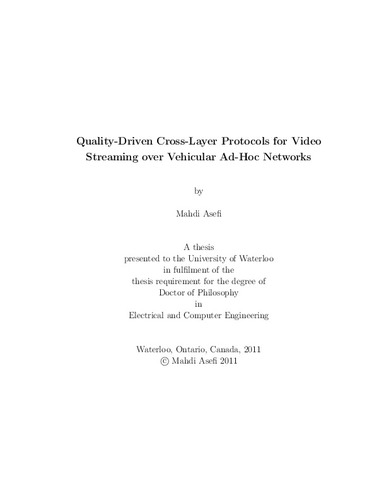| dc.description.abstract | The emerging vehicular ad-hoc networks (VANETs) offer a variety of applications
and new potential markets related to safety, convenience and entertainment, however,
they suffer from a number of challenges not shared so deeply by other types of existing
networks, particularly, in terms of mobility of nodes, and end-to-end quality of service
(QoS) provision. Although several existing works in the literature have attempted to
provide efficient protocols at different layers targeted mostly for safety applications, there remain many barriers to be overcome in order to constrain the widespread use of such networks for non-safety applications, specifically, for video streaming: 1) impact of high
speed mobility of nodes on end-to-end QoS provision; 2) cross-layer protocol design while keeping low computational complexity; 3) considering customer-oriented QoS metrics in the design of protocols; and 4) maintaining seamless single-hop and multi-hop connection between the destination vehicle and the road side unit (RSU) while network is moving.
This thesis addresses each of the above limitations in design of cross-layer protocols for video streaming application. 1) An adaptive MAC retransmission limit selection scheme is proposed to improve the performance of IEEE 802.11p standard MAC protocol for video streaming applications over VANETs. A multi-objective optimization framework, which jointly minimizes the probability of playback freezes and start-up delay of the streamed video at the destination vehicle by tuning the MAC retransmission limit with respect to channel statistics as well as packet transmission rate, is applied at road side unit (RSU). Two-hop transmission is applied in zones in which the destination
vehicle is not within the transmission range of any RSU. In the multi-hop scenario, we
discuss the computation of access probability used in the MAC adaptation scheme and propose a cross-layer path selection scheme; 2) We take advantage of similarity between multi-hop urban VANETs in dense traffic conditions and mesh connected networks. First, we investigate an application-centric routing scheme for video streaming over mesh connected overlays. Next, we introduce the challenges of urban VANETs compared to mesh networks and extend the proposed scheme in mesh network into a protocol for urban VANETs. A classification-based method is proposed to select an optimal path for video streaming over multi-hop mesh networks. The novelty is to translate the path selection
over multi-hop networks to a standard classification problem. The classification is based on minimizing average video packet distortion at the receiving nodes. The classifiers are trained offline using a vast collection of video sequences and wireless channel conditions in order to yield optimal performance during real time path selection. Our method substantially reduces the complexity of conventional exhaustive optimization methods and results in high quality (low distortion). Next, we propose an application-centric routing scheme for real-time video transmission over urban multi-hop vehicular ad-hoc network
(VANET) scenarios. Queuing based mobility model, spatial traffic distribution and prob-
ability of connectivity for sparse and dense VANET scenarios are taken into consideration
in designing the routing protocol. Numerical results demonstrate the gain achieved by
the proposed routing scheme versus geographic greedy forwarding in terms of video frame distortion and streaming start-up delay in several urban communication scenarios for various vehicle entrance rate and traffic densities; and 3) finally, the proposed quality-driven
routing scheme for delivering video streams is combined with a novel IP management
scheme. The routing scheme aims to optimize the visual quality of the transmitted video
frames by minimizing the distortion, the start-up delay, and the frequency of the streaming freezes. As the destination vehicle is in motion, it is unrealistic to assume that the vehicle will remain connected to the same access router (AR) for the whole trip. Mobile IP management schemes can benefit from the proposed multi-hop routing protocol in order to adapt proxy mobile IPv6 (PMIPv6) for multi-hop VANET for video streaming applications. The proposed cross-layer protocols can significantly improve the video streaming quality in terms of the number of streaming freezes and start-up delay over VANETs while achieving low computational complexity by using pattern classification methods for optimization. | en |

